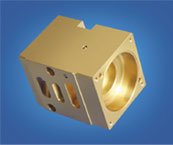Milled plastic parts
PROTEC GMBH Zerspanungstechnik
77716-D Haslach im Kinzigtal
12 Schleifmattstr.
+49 7832 7090
+49 7832 70950
Milled plastic parts
Anfrage an Anbieter senden
Milling plastic parts involves the use of milling machines to shape and cut plastic material into the desired components. Here's a guide to milling plastic parts:
-
Material Selection:
- Choose the appropriate plastic material for your application. Common plastics for milling include ABS, PVC, POM (acetal), and various types of nylon. Consider factors such as material properties, machinability, and the desired end-use characteristics.
-
Tool Selection:
- Select cutting tools suitable for milling plastic. Carbide end mills with sharp cutting edges are commonly used. Consider using tools with high shear angles and low rake angles to minimize heat generation.
-
Cutting Speeds and Feeds:
- Adjust cutting speeds and feeds based on the specific plastic material and part geometry. Plastics generally require lower cutting speeds compared to metals to prevent overheating and melting. Experiment with cutting parameters to find the optimal balance between speed and quality.
-
Coolant and Lubrication:
- While plastics don't generate as much heat as metals during machining, using a coolant or lubricant can still be beneficial. Coolants help to dissipate heat, reduce friction, and improve surface finish. Consider water-soluble coolants for plastics.
-
Workholding:
- Secure the plastic workpiece using appropriate workholding methods. Vacuum tables, clamps, or custom fixtures may be used depending on the part geometry and material properties.
-
Tool Path Optimization:
- Optimize toolpaths to minimize tool changes, reduce cycle times, and achieve a smooth surface finish. Efficient programming can help minimize tool wear and maximize machine productivity.
-
Chip Control:
- Proper chip control is important to prevent chip entanglement and ensure a clean milling process. Adequate chip evacuation helps avoid re-cutting of chips, leading to improved surface finish.
-
Surface Finish Considerations:
- Pay attention to the desired surface finish of the plastic part. Adjust cutting parameters and tool selection to achieve the required surface quality. Plastics often require post-machining processes like polishing for specific applications.
-
CNC Programming:
- Develop CNC programs with precision and accuracy. Consider factors such as toolpath optimization, tool changes, and tool offsets. Thoroughly simulate and test the program before running it on the CNC milling machine.
-
Quality Control:
- Implement quality control measures to inspect critical dimensions and tolerances. Regularly check the milled parts to ensure they meet specifications.
-
Post-Machining Processes:
- Depending on the application, consider any required post-machining processes such as deburring, cleaning, or additional surface treatments. These processes contribute to the final appearance and functionality of the milled plastic parts.
-
Documentation and Traceability:
- Maintain comprehensive documentation for each milled plastic part, including material certifications, inspection reports, and CNC programs. Establish traceability to track the manufacturing history of each component.
-
Safety Precautions:
- Follow safety guidelines when operating CNC milling machines. Wear appropriate personal protective equipment (PPE) and be aware of the specific safety considerations associated with milling plastic, such as the potential for static electricity.
Turning
Gridding
Milling



